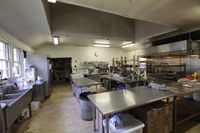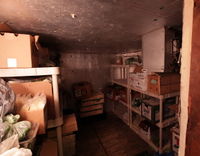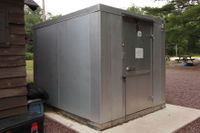Head Cook
| Physical Capability | Required |
|---|---|
| Long periods of standing | yes |
| Walking long distances | no |
| Heavy lifting | yes |
Time required: Plan and purchase some items before camp; at camp from move-in to move-out time with some days of break in between, if required
Work Requirements
- Must be able to work on the griddle and ovens.
- Must be able to lift boxes up to 30 lb.
- Must have knowledge of food safety.
- Experience in quantity cooking preferred. Types of dishes: stocks, soups, sauces, eggs, dairy, salads, sandwiches, cereals, fruits, vegetables, meat, poultry, pasta, fish, pizza.
Responsibilities
- Manage all kitchen operations (direct kitchen helpers & server).
- Review prepared menu (supplied by Food Supply Manager). Familiarize yourself with items needed for each day’s meals.
- Prepare and cook full course meals. Determine size of food proportions. Ensure quality of food.
- Prepare afternoon snacks and and put it on the dining hall table at the beginning of free time, around 3:35pm. This can be fruits, such as watermelon or apple pieces.
- Prepare dishes for campers with food intolerances and other special needs (children).
- Ask director for food allergies campers have listed. Keep a visible list of campers’ names and allergies. Prepare food with these allergies in mind. Parents can be asked to provide/prepare special foods if needed.
- Make sure all food safety rules are observed. Read ServSafe booklet provided at camp and all the points further down under Food Safety Requirements.
- Instruct everyone in the kitchen (helpers, servers, cleanup team) about food safety and make sure that instructions are followed. Makes sure no children under 12 years old serve food to others or are involved in any other kitchen operations.
- Instruct the meal serving coordinator, kitchen cleanup coordinator, the dining hall manager, and the drink manager. (You should be familiar with their job description.)
- Inspect kitchen and food service areas for cleanliness and safety.
- In the evening of the arrival day, after general orientation, hold a meeting with all kitchen staff and make sure everyone understands their volunteer assignment and is familiar with all food safety instructions. (If Food Supply Manager is also at camp, coordinate who will perform this task.)
- On the first full day at camp, stay with cleanup coordinator for each meal (probably a different person for breakfasts, lunches and dinners each) to be sure they know how to clean the kitchen and dining hall and properly put the food leftovers in containers and store them in the refrigerator.
- Begin dinner prep early for first day, ask for help. Dinner crew may not arrive in time to help.
- Early food preparation (recommended if you have time): Mince all fresh garlic in food processor, put in small bags, put in kitchen freezer
- Receive Driscoll food deliveries (compare items delivered with your order sheet for accuracy and report missing or damaged items to Driscoll right away (so that we won’t be charged for them). Make sure to get 2 copies of the invoice; keep one for your records and give the other to the bookkeeper.
- Keep track of inventory, place additional Driscoll order (if needed) before 3:00pm for next day delivery or on Friday for Monday delivery.
- Prepare shopping list if needed for General Affairs. They usually go shopping after breakfast. If needed, include cleaning materials like dish washing soap and sponges.
- If there is a lot of leftover food and/or unused food items, adjust the menu and the next food delivery order to avoid waste of food and money.
- Save all yogurt (and cheese) containers and lids to store food for move out crew at the end of camp. These will be thrown out. Save some plastic ware and plates/bowls for moveout crew meals.
- Double-check dinner times with camp directors. They often are different for different days, depending on the evening activities.
- Communicate with camp director if a meal is late as soon as this becomes clear.
Meal Preparation Times
- Breakfast: 1.5–2 hours (start at 6am)
- Lunch: 2 hours (start at 10am)
- Dinner: 3 hours (start at 2 or 3pm)
Food Safety Requirements
- Check walk-in refrigerator and make sure that the food-inspector-approved method of storing vegetables has been applied: Meat on bottom shelves, vegetables above. Temperature must be lower than 38 degrees.
- All items must be 6 inches or more above floor (on wooden pallets and then on the lowest shelf is OK).
- Plastic crates are accepted to be used in the walk-in refrigerator, if needed, but they first need to be cleaned by dipping them for 15 second in water with a disinfectant.
- Check walk-in freezer. Meat always stored on bottom shelves. Veggies above to avoid cross contamination. Temperature must be 0 or lower. Move frozen food out of the walk-in freezer and into the walk-in refrigerator two days before needed.
- If you are unclear about safety rules, check The United States Department of Agriculture’s Food Safety Regulations at https://www.fsis.usda.gov/wps/portal/fsis/topics/food-safety-education/get-answers/food-safety-fact-sheets/safe-food-handling/basics-for-handling-food-safely/ct_index
- Ensure all kitchen helpers/servers wear hairnets and one-size clear gloves.
- Change gloves after cutting meat, using toilet, etc.
- Wash all food before cutting
- Wash cans before opening
- Wash and sterilize knives/cutting boards/work space after preparing each item.
- No backpacks in kitchen (servers/dishwashers)
- Everyone should wash dishes and work area while they work on food preparation.
- Never leave food sitting out or take out more food of freezer or refrigerator than you need.
- Never place unwashed food on prep areas. For example, do not bring a box of lettuce into the kitchen. Go into walk-in with a clean bowl and count out how many bunches you need into the bowl. Take bowl to sink and wash.


